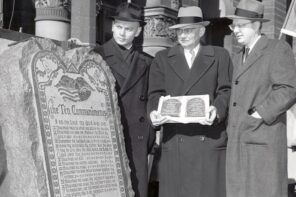I hate to break it to you, but Noah’s Flood is not a real thing. As geologist David Montgomery wrote in his recent history, The Rocks Don’t Lie: A Geologist Investigates Noah’s Flood, the religious idea that the Flood was real has been important to the actual history of geology as a science. But by now, however, science knows better. I can’t say as much for the media.
Drumming up attention for Christiane Amanpour’s two-part special “Back to the Beginning,” (concluding this evening) of which the search for Noah’s Flood is but a small part, ABC TV’s promotional materials give life to the old myth: “now an acclaimed underwater archaeologist thinks he has found proof that the biblical flood was actually based on real events.”
The acclaimed underwater archaeologist is none other than Robert Ballard, whose name is always and forever attached to his major discovery: the wreck of the Titanic. Which allows ABC to make the first of many misleading associations, of Ballard and Noah’s Ark, not Noah’s Flood. This guy discovered one big ship, he can discover another. Of course, legitimate science has long ago given up on finding the Ark itself. As biblical archaeology watchdog Eric Cline wrote in a Boston Globe editorial in 2007, “When most archeologists and biblical scholars hear that someone has (yet again) discovered Noah’s Ark, they roll their eyes and get on with their business.”
Finding evidence for an ancient flood is certainly possible. But the second misconception here is that Ballard’s evidence is anything new. Read closer and you’ll find that Ballard’s theory about a massive, sudden flooding of the Black Sea 7,600 years ago was first put forward in 1996 by Columbia scientists William Ryan and Walter Pitman. Their book about it came out in January 2000. That fall, Ballard was the leader of a National Geographic expedition to the Black Sea expressly to test the idea.
A third misconception is that a Black Sea flood could ever be “worldwide.” The idea that it could is inextricably linked to “flood geology,” the fake-science backbone of creationism. Counterintuitively for a literalist movement, the makers of the infamous Creation Museum do not attempt to pinpoint the physical location of Noah’s Flood. For them, the Flood must have been real, but it must have been total, and thus no beginning point can be found. Otherwise God’s wrath is not total, and there is no ominous foreshadowing of a future end-times and Rapture. They are vigilant about debunking anyone who tells them otherwise. See what they said about Ryan and Pitman here.
Let me state for the record: many archaeologists and geologists have discovered evidence for many different floods, some of them large, or sudden, or both. But they all have end points, high water marks if you will. They certainly did not cover the entire Earth. (Sorry, creationists.)
So to say, as the Daily Mail did, that Ballard has discovered “A flood of Biblical proportions just like in the story of Noah’s Ark” is meaningless.
The phrase “of biblical proportions” is an idiomatic expression that does not carry any quantitative weight; it just means “big.” But how big would the flood have needed to be in order to be Noah’s flood? Not even the biblical literalists can agree on how long the “cubit” measure mentioned in the Bible’s flood story should be. So how should we expect science to define our biblical proportions?
There is no way to know whether any of these floods even covered all of the earth that the inhabitants of that area knew about. The much-referenced existence of many different local flood legends around the world does not mean that they are all describing the same flood: it means that floods happen everywhere. As Montgomery told me in an interview this fall, “the real insights are in the differences between the flood stories.”
And even if we could be sure that, say, the inhabitants of the Black Sea area did think that their whole world was covered in water, we would still not be able to link that conception with a biblical character called Noah. Yes, the Bible’s flood myth can be successfully linked to documented Sumerian and Babylonian mythology in several respects; most notably the sequence of birds sent out by the savior of humanity (in Babylonian, his name is Utnapishtim) to ascertain whether or not the flood waters had receded. But the whole moral lesson of the Bible’s Noah’s Ark story—that God punished humanity for our wicked deeds—has no place in these earlier tellings. The Babylonian weather god Enlil tried to flood out mankind because all of our noise was keeping him awake. But Ea the water god took pity on good king Utnapishtim and foiled his plan. There is not, and never will be, “new evidence” definitively linking one or the other of these floods to the pre-Babylonian flood story that eventually ended up, much revised, in the Bible.
Of course, none of this means that we will stop hearing breathless reports of new evidence for Noah’s Ark, and/or a biblical flood. I guess “Columbia earth scientists posit large Black Sea flood 7,600 years ago, which may or may not be the inspiration for the Sumerian epic of Utnapishtim, and we’ll never know for sure,” just doesn’t make for good headlines.




